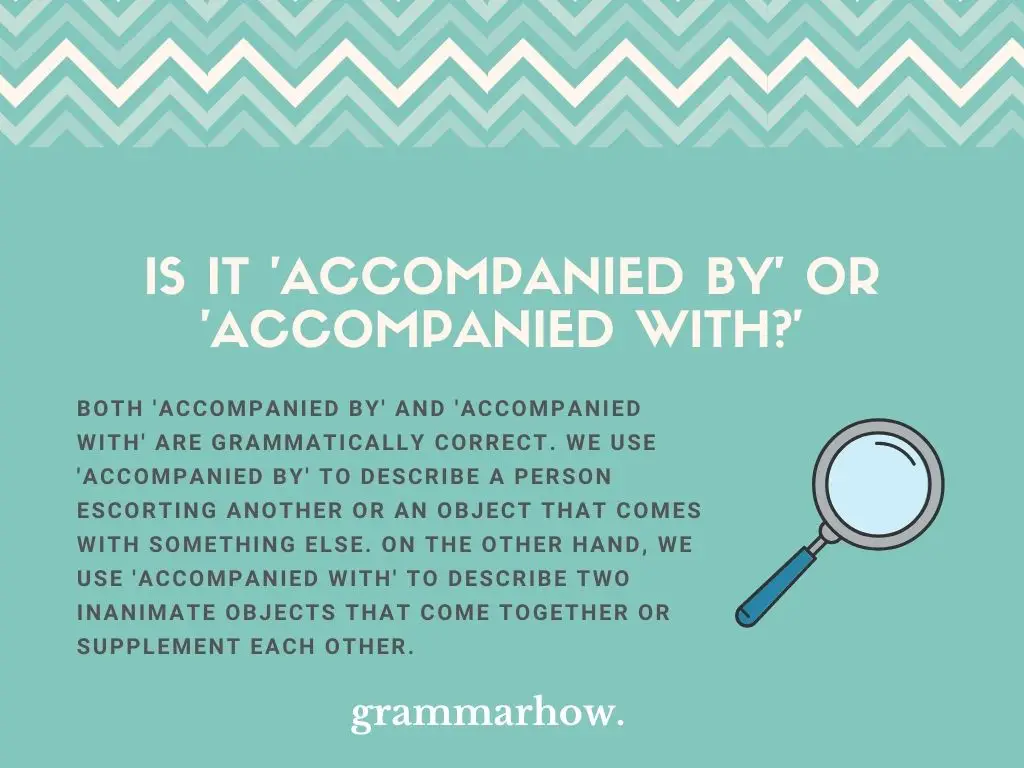Despite how short and trivial they look in a sentence, prepositions can be essential players in developing a sentence’s meaning. Whether you use ‘by,’ ‘with,’ or anything in between can change what you’re trying to say. Like, is it ‘accompanied by’ or ‘accompanied with?’ Let’s see what the two imply.
Is It ‘Accompanied By’ Or ‘Accompanied With?’
Both ‘accompanied by’ and ‘accompanied with’ are grammatically correct. We use ‘accompanied by’ to describe a person escorting another or an object that comes with something else. On the other hand, we use ‘accompanied with’ to describe two inanimate objects that come together or supplement each other.

‘Accompany’ acts as a transitive verb which means it always has a direct object or a noun that receives the action. Take a look at the example below.
- Brent will accompany Julia to the movies.
In the active voice, it tells that Brent is the doer and Julia is the receiver of Brent’s accompanying.
‘Accompany by’ and ‘accompany with’ are both in the passive voice. So, the phrase emphasizes the receiver more than the doer, making the sentence, ‘Julia is accompanied by Brent to the movies’ in the same example.
What Does ‘Accompanied By’ Mean?
We use ‘accompany by’ when referring to a person escorting another person. For example, ‘she was accompanied by her mother.’ However, the phrase can also refer to an object that goes with another thing. For example, ‘waffles are accompanied by syrup.’
In this context, the preposition ‘by’ means to the agency, instrumentality, or means of something. So, when we say ‘Tricia was accompanied by Jill,’ we mean that the accompaniment was done through the agency of Jill.
Using ‘by’ with an inanimate object means that two things come together or simultaneously. It means that one object goes with something else. So, when we say ‘waffles are accompanied by syrup,’ we mean that waffles and syrup come together or simultaneously.
Below are examples of how to use ‘accompanied by’ in a sentence.
- Anthony was accompanied by Eric to the theater.
- The children will be accompanied by their parents during the ceremony.
- Don’t worry, I’ll be accompanied by John during the interview.
- French fries is better accompanied by ketchup than gravy.
- I like the design to be balloons accompanied by conffetti.
- The guests of the dinner party were accompanied by good music.
- Stacy was accompanied by her teachers to the math contest.
What Does ‘Accompanied With’ Mean?
We use ‘accompany with’ when referring to an inanimate object that accompanies another inanimate object. For example, we say ‘the pork was accompanied with fine red wine.’ However, we usually do not use the phrase when referring to accompaniment done by people.
In this context, we take the meaning of the preposition ‘with’ which is to express a combination, addition, or presence of something. In this sense, saying ‘pork accompanied with red wine’ means that the pork and wine are a combination or that wine is in addition to pork.
In the same context, it is off to use ‘accompanied with’ for people. For example, ‘she was accompanied with her parents’ implies that she and her parents are a combination, or ‘she’ in addition to her parents which is not our intended meaning.
Below are examples of how to use ‘accompanied with’ in a sentence.
- I like my burger accompanied with fries and cola.
- They submitted a paper accompanied with supporting data and evidence.
- For the main course, steak accompanied with pasta and a side of veggies.
- I like my new shoes accompanied with a new pair of socks.
- I bought notebooks accompanied with color-matching pens.
- The bad hotel location was also accompanied with road difficulties.
- The lobster was accompanied with scallops and braised vegetables.
Are ‘Accompanied By’ And ‘Accompanied With’ Interchangeable?
‘Accompanied by’ and ‘accompanied with’ may be interchangeable but only when referring to inanimate objects. For example, ‘steak accompanied with wine’ and ‘steak accompanied by wine’ both work. However, we cannot say ‘Stacy accompanied with Brian.’ We can only say ‘Stacy accompanied by Brian.’
Is ‘Accompanied By’ Or ‘Accompanied With’ Used The Most?
According to the Google Ngram Viewer, ‘accompanied by’ is used more often than ‘accompanied with.’ It is most probably because ‘accompanied by’ is more versatile and can be used either with people or inanimate objects. On the other hand, ‘accompanied with’ is only for inanimate objects.

It is also essential to note that ‘accompanied with’ is rarely used today and may even be considered grammatically incorrect by some English speakers. So, it’s also best to use ‘accompanied by’ in any case.
Can ‘Accompanied’ Be Used With Other Prepositions?
We often do not use ‘accompanied’ with prepositions other than ‘with’ or ‘by.’ Since ‘accompanied’ is often used as a passive, transitive verb, it needs to be paired with prepositions that can clearly express relationships such as receivers and doers. ‘With’ are ‘by’ are the most appropriate prepositions for this.

Martin holds a Master’s degree in Finance and International Business. He has six years of experience in professional communication with clients, executives, and colleagues. Furthermore, he has teaching experience from Aarhus University. Martin has been featured as an expert in communication and teaching on Forbes and Shopify. Read more about Martin here.
